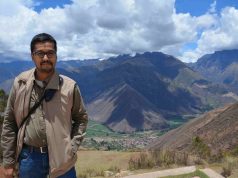 By DURGESH PANT
By DURGESH PANT
The Himalayan-Hindukush region stands today at one of the most crucial turning points in human history. These mountains, often imagined as symbols of serenity and permanence, are in fact living, evolving, and deeply fragile ecosystems. They constitute the planet’s ‘Third Pole’, storing vast reserves of ice and feeding great river systems that support nearly a billion people across South Asia. Yet beneath their majestic surface lies a landscape undergoing extraordinary pressure. The Himalayas are young mountains, still rising and still colliding among themselves beneath the earth. This geological dynamism, combined with the intensifying pressures of climate change, has turned the region into one of the world’s most volatile ecological systems. What appears timeless is, in reality, transforming rapidly and often violently.
For decades, we believed the Himalayas to be immovable guardians of the Indian subcontinent. But the scientific truth is considerably more complex. The region is warming faster than the global average, glaciers are melting with alarming speed, weather patterns are shifting unpredictably, and extreme events such as flash floods, cloudbursts, glacial lake outburst floods, avalanches, and landslides are occurring with unprecedented frequency. In this rising uncertainty, Uttarakhand occupies a position of immense importance. It is a state that has already endured a long history of devastating events, from the 2013 Kedarnath tragedy to recurring landslides across the Char Dham routes, from cloudbursts in Chamoli to soil collapses in Pithoragarh and Bageshwar. Each disaster has displayed the ecological vulnerability of the mountains we so dearly love.
Among the incidents that have deeply etched themselves in public memory, the Silkyara tunnel collapse of 2023 stands out for its symbolic significance. On 12 November 2023, the under-construction Silkyara-Barkot tunnel in Uttarkashi suddenly caved in, trapping 41 workers deep inside the mountain for seventeen harrowing days. The rescue operation became an extraordinary saga of courage, and innovation. The mountain, composed of fractured rock and unstable strata, resisted every conventional approach. Under the guidance of Prime Minister Narendra Modi, the Chief Minister of Uttarakhand Pushkar Singh Dhami exhibited exemplary leadership to save all the lives. Our engineers and responders deployed advanced machinery, laser-guided drilling equipment, vertical boring techniques, and eventually were successful with manual rat-hole mining in the final stretch.
This need for greater caution becomes even more urgent when we consider the tectonic pressures silently accumulating beneath Uttarakhand. Recent geophysical readings and satellite-based interferometric studies show that a stretch of nearly 250 kilometres, from Tanakpur in the east to Dehradun in the west, is experiencing surprisingly low crustal movement. While the Indian plate continues to push northward at a steady pace, the upper crust in this region appears locked, absorbing strain rather than releasing it through gradual seismic activity. This discrepancy is alarming because it indicates the build-up of potential energy that could one day be released suddenly in the form of a large earthquake. Scientists caution that this segment of the Himalayas could produce a seismic event in the range of magnitude 7 to 8, capable of triggering massive landslides, slope failures, river blockages, and widescale destruction. Unlike floods or storms, earthquakes strike without warning. And in a mountainous landscape where towns line steep slopes, houses perch on loose sediments, and roads cling to fragile ridges, the consequences could be devastating. Uttarakhand must reckon with this reality before it is forced to confront it in catastrophe.
Collaborative model for Himalayan Resilience: World Summit on Disaster Management
| The world is increasingly searching for pathways to build resilience amidst climatic uncertainty. Uttarakhand has the opportunity to become a beacon of that possibility. |
Prime Minister Narendra Modi has often remarked that “Uttarakhand will have to lead the way for the rest of the world”. This is not just a statement of aspiration but a recognition of the state’s strategic and symbolic importance. Uttarakhand is the ecological heart of the Himalayas, a key source of India’s river systems, a sanctuary of biodiversity, and a flourishing spiritual destination. Uttarakhand is developing into a model of sustainable, scientifically informed mountain governance, which will serve as a template for the entire Himalayan arc stretching into the Hindu Kush.
For centuries, the state has been celebrated as Dev-Bhoomi, the Land of the Gods, a place of pilgrimage, purification, and spiritual renewal. This heritage is invaluable and continues to shape the cultural and emotional identity of our people. But spirituality alone cannot shield us from the escalating risks of climate change and associated disasters. As we move deeper into the 21st century, Uttarakhand must also embrace its identity as Yukti-Bhoomi, the land of reason, knowledge, and solutions. This means grounding our development choices in science, investing in climate education for youth, respecting traditional ecological wisdom, strengthening early warning systems, designing mountain-appropriate infrastructure, and restoring natural buffers like forests and wetlands that protect us far more effectively. A resilient Uttarakhand is one where devotion and knowledge reinforce one another, where the sanctity of the mountains inspires responsibility, and scientific insight informs every decision.
It is in the larger scientific, ecological and geological context of Himalayas that the World Summit on Disaster Management (WSDM) emerges as not merely relevant but profoundly necessary. WSDM is a vision that integrates science, policy, technology, community knowledge, and international cooperation. Hosting WSDM in Dehradun is not an accident of convenience; it is a purposeful choice rooted in the recognition that Uttarakhand embodies the very challenges the global community must learn to navigate. Climate change, ecological fragility, seismic uncertainty, rapid development, and the pressure of tourism all converge here. This makes Uttarakhand the perfect living laboratory for designing future-ready solutions for mountain regions worldwide.
WSDM represents the idea that resilience must be built before disasters strike, not after. It stands for collaboration across disciplines; geologists working with hydrologists, emergency responders sitting with AI innovators, and global policymakers learning from Himalayan villagers who have lived in harmony with their environment for centuries. It embodies the belief that mountain states cannot simply replicate plains-based development models but must lead in designing new paradigms that respect the unique demands of high-altitude ecosystems. In bringing the world to Dehradun, WSDM signals that Uttarakhand is ready to step into a leadership role that transcends its geographical size.
As WSDM prepares to convene in Dehradun on 28 November, its scale underscores the urgency and global relevance of this moment. World summit is drawing representatives from all the continents across the globe, participants from all the Himalayan nations, alongside nationwide participation from institutions, research bodies, and disaster-response agencies from India. Yet, what truly distinguishes this summit is that it is not limited to global leaders or regional & national policymakers. It is equally a platform for the people of Uttarakhand themselves, those who live in the mountains, understand their moods, and face their challenges daily.
From Askot to Arakot, from Munsiyari to Mana, and across every block of the state, representatives from villages, panchayats, education institutions, and community networks are participating. They bring with them lived wisdom and the grounded experience of surviving cloudbursts, landslides, isolation, and the complexities of high-altitude life. The participation of these communities reflects the spirit of a population ready to embrace the opportunities of Glocalization, where global knowledge converges with local insight to create context-specific solutions. It demonstrates that the people of Uttarakhand who are rooted in their traditions yet open to innovation, are prepared to learn, adapt, and collaborate in shaping a safer, more resilient future for the mountains. With the participation of such diverse stakeholders, Uttarakhand is now moving from reactive disaster response to proactive resilience-building, cultivate a culture that respects the limits of its terrain, learns from past tragedies, and anticipates future risks.
World Summit on Disaster Management is a powerful stepping stone in this journey, bringing global expertise to Uttarakhand while simultaneously showcasing local wisdom to the world. The summit is a declaration that Uttarakhand will not merely be a witness to climate change but a leader in confronting it. With thoughtful governance, scientific planning, and collaborative efforts that unite government, academia, local communities, and global partners, the state is emerging as a model for the entire Himalayan-Hindukush region.
(Article written by Durgesh Pant, Director General Uttarakhand state Council for Science and Technology (UCOST)







